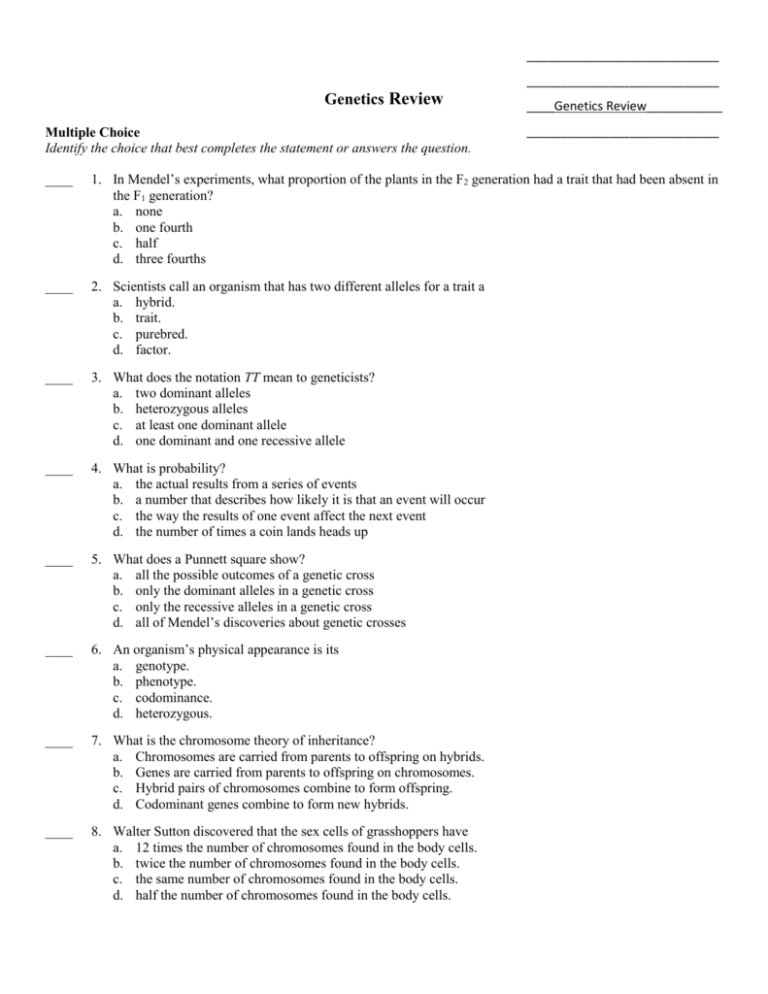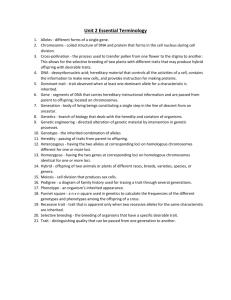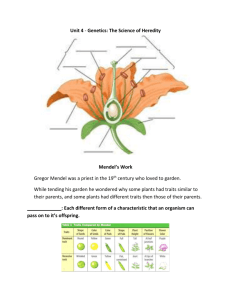Genetics Review
advertisement

____________________________ ____________________________ Genetics Review Multiple Choice Identify the choice that best completes the statement or answers the question. ____Genetics Review___________ ____________________________ _ ____ 1. In Mendel’s experiments, what proportion of the plants in the F2 generation had a trait that had been absent in the F1 generation? a. none b. one fourth c. half d. three fourths ____ 2. Scientists call an organism that has two different alleles for a trait a a. hybrid. b. trait. c. purebred. d. factor. ____ 3. What does the notation TT mean to geneticists? a. two dominant alleles b. heterozygous alleles c. at least one dominant allele d. one dominant and one recessive allele ____ 4. What is probability? a. the actual results from a series of events b. a number that describes how likely it is that an event will occur c. the way the results of one event affect the next event d. the number of times a coin lands heads up ____ 5. What does a Punnett square show? a. all the possible outcomes of a genetic cross b. only the dominant alleles in a genetic cross c. only the recessive alleles in a genetic cross d. all of Mendel’s discoveries about genetic crosses ____ 6. An organism’s physical appearance is its a. genotype. b. phenotype. c. codominance. d. heterozygous. ____ 7. What is the chromosome theory of inheritance? a. Chromosomes are carried from parents to offspring on hybrids. b. Genes are carried from parents to offspring on chromosomes. c. Hybrid pairs of chromosomes combine to form offspring. d. Codominant genes combine to form new hybrids. ____ 8. Walter Sutton discovered that the sex cells of grasshoppers have a. 12 times the number of chromosomes found in the body cells. b. twice the number of chromosomes found in the body cells. c. the same number of chromosomes found in the body cells. d. half the number of chromosomes found in the body cells. ____ 9. What happens during meiosis? a. Two sex cells combine. b. Chromosome pairs separate and are distributed into new sex cells. c. Each sex cell copies itself to form four new chromosomes. d. Chromosome pairs remain together when new sex cells are formed. ____ 10. What determines the genetic code? a. the order of nitrogen bases along a gene b. the number of nitrogen bases in a DNA molecule c. the order of amino acids in a protein d. the number of guanine and cytosine bases in a chromosome ____ 11. What does messenger RNA do during protein synthesis? a. copies the coded message from the DNA and carries it into the cytoplasm b. copies the coded message from the DNA and carries it into the nucleus c. carries amino acids and adds them to the growing protein d. copies the coded message from the protein and carries it into the nucleus ____ 12. What do transfer RNA molecules do during protein synthesis? a. copy the coded message from the protein and carry it into the nucleus b. copy the coded message from the DNA and carry it into the nucleus c. carry amino acids and add them to the growing protein d. copy the coded message from the DNA and carry it into the cytoplasm ____ 13. What is a mutation? a. any change that is harmful to an organism b. any change in a gene or chromosome c. any change that is helpful to an organism d. any change in the phenotype of a cell ____ 14. The different forms of a gene are called a. alleles. b. factors. c. masks. d. traits. ____ 15. Where does protein synthesis take place? a. in the ribosomes in the nucleus of the cell b. on the ribosomes in the cytoplasm of the cell c. in the chromosomes in the nucleus of the cell d. on the chromosomes in the cytoplasm of the cell ____ 16. An organism’s genotype is its a. genetic makeup. b. feather color. c. physical appearance. d. stem height. ____ 17. A heterozygous organism has a. three different alleles for a trait. b. two identical alleles for a trait. c. only one allele for a trait. d. two different alleles for a trait. Completion Complete each statement. 18. The process in which a parent cell divides twice to produce sex cells is called __________________________. 19. Genes are carried from parents to their offspring on structures called ________________________________. 20. A chart used to predict results of genetic crosses is known as a(n) ________________________________. 21. If a(n) ________________________________ allele is present, its trait will appear in the organism. 22. A ________________________________ is the offspring of parents that have different alleles for a trait. 23. An organism’s ________________________________ is its allele combinations. 24. The substitution of one base for another during DNA replication is an example of a(n) ________________________________. 25. Mendel used the principles of ________________________________ to predict what percent of offspring would show a particular trait. 26. Alleles that are neither dominant nor recessive produce an inheritance pattern known as ________________________________. 27. A set of three bases codes for one specific ________________________________ in a protein. 28. A(n) ________________________________ organism is the offspring of many generations of organisms that have the same trait. 29. A pea plant that is ________________________________for tall stems has the alleles Tt. 30. ________________________________ carries coded messages from the nucleus to the cytoplasm. 31. ________________________________ adds amino acids to a growing protein. 32. An organism that has two dominant or two recessive alleles is said to be ______________________________ for that trait. Use the diagram to answer each question. 33. In the F1generation, what is the genotype of the offspring? ________ What is their phenotype? _______________________________________ 34. In the F2 generation, what percent of the offspring have white flowers? __________ What are the genotypes of the white-flowered offspring? ________, ________ 35. There is a herd of black rabbits and white rabbits. Two heterozygote black rabbits mated. Create the Punnett square. Use the letter R/r. ________ ________ ________ ________ Essay Fully answer all of the following questions with detailed explanation. 36. Fully explain why Mendel’s cross of purebred tall and short pea plants resulted in only tall plants. Be sure to include a Punnett square to support your answer. _________________________________________________ _________________________________________________________________________________________ _________________________________________________________________________________________ _________________________________________________________________________________________ _________________________________________________________________________________________ _________________________________________________________________________________________ _________________________________________________________________________________________ 37. Some clover plants have leaves with a white stripe. Other clover plants have leaves with a white spot. When these two types of plants are crossed, the leaves of the offspring have a white stripe and a white spot. Explain how this inheritance pattern occurs.____________________________________________________________ _________________________________________________________________________________________ _________________________________________________________________________________________ _________________________________________________________________________________________ _________________________________________________________________________________________ _________________________________________________________________________________________ _________________________________________________________________________________________ 38. Define both harmful and helpful mutations. Next, give an example of both of these mutations; be sure to explain why it is helpful or harmful. ___________________________________________________________ _________________________________________________________________________________________ _________________________________________________________________________________________ _________________________________________________________________________________________ _________________________________________________________________________________________ _________________________________________________________________________________________ _________________________________________________________________________________________ 39. Describe what messenger RNA and transfer RNA do during protein synthesis. __________________________ _________________________________________________________________________________________ _________________________________________________________________________________________ _________________________________________________________________________________________ _________________________________________________________________________________________ _________________________________________________________________________________________ _________________________________________________________________________________________







